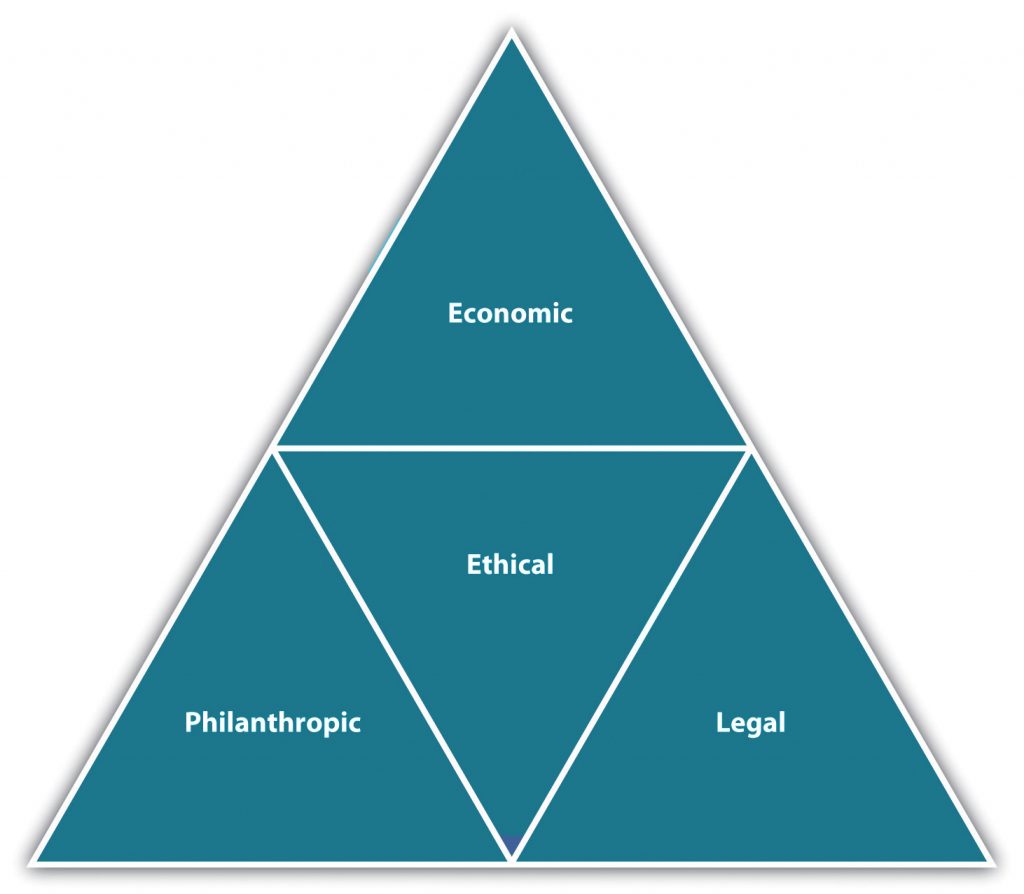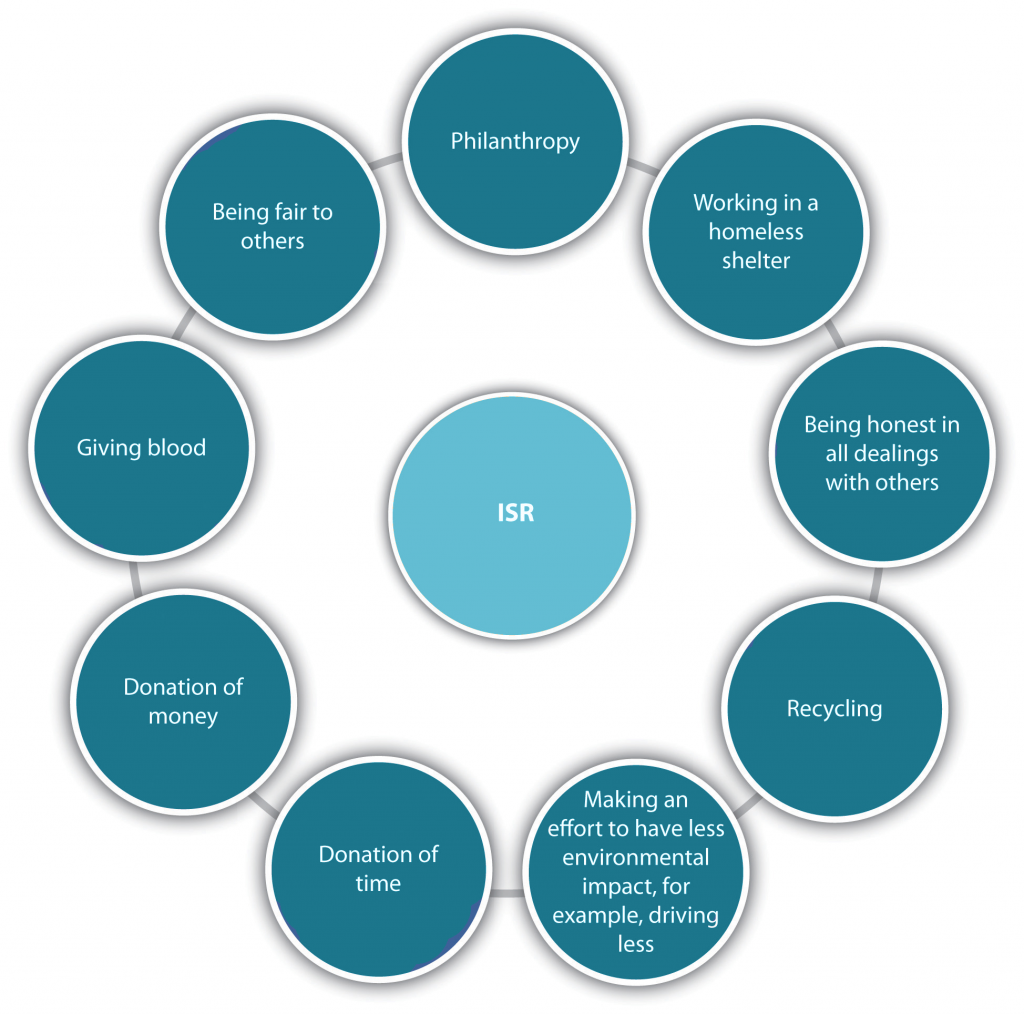12.3 Social Responsibility
No chapter on ethics would be complete without a discussion on social responsibility. People, not only companies, can engage in social responsibility. Being socially responsible shows both social awareness and self-management skills—that is, an awareness of how our decisions affect others. This section will first discuss social responsibility on the corporate level and then social responsibility on the individual level. As we discussed with ethical company standards, it is difficult to separate corporate ethics and corporate social responsibility from individual ethics and social responsibility, since people are the ones making the corporate policies. For purposes of this section, we will first discuss social responsibility on the corporate level and then on the individual level.
Since social responsibility was first mentioned in the 1960s, companies have felt pressure from society to behave in a more socially responsible manner. Social responsibility is the duty of business to do no harm to society. In other words, in their daily operations, businesses should be concerned about the welfare of society and mindful of how its actions could affect society as a whole. We know that social responsibility doesn’t always happen and profits are sometimes put first.
Ideally, companies should look at four main areas of social responsibility and act ethically in all four areas. In fact, even as individuals we should be aware of these areas of social responsibility, which we will discuss in this section (Carroll, 1991). Those four areas are the following:
- Economic aspects. Companies need to maintain strong economic interests so they can stay in business. Being profitable and providing value to shareholders is part of a company being socially responsible.
- Legal aspects. A company must follow the law and have a legal obligation to do so. For example, car companies are required to meet a certain level of emissions standards in car production.
- Ethical aspects. Acting ethically means going above and beyond the legal requirements and meeting the expectations of society. The ethical expectations (and outrage) of society can encourage companies to act ethically.
- Philanthropic aspects. This is the expectation that companies should give back to society in the form of charitable donations of time, money, and goods.
Based on these areas, many believe business should go above and beyond the law to act ethically, meet expectations of society, and even go beyond by donating profit back to the communities in which the businesses operate. As we mentioned at the start of this section, businesses are not the only ones who engage in social responsibility. Since people run businesses, often we see business social responsibility initiatives that are directly related to individuals in the organization.

More recently, social responsibility has been looked at as going above and beyond even philanthropy. Past ideas on social responsibility implied that businesses must trade off social responsibility for profits—in other words, in order to make profit, businesses had to actually harm society. This way of thinking has changed with the idea of creating shared value. This concept, created by Michael E. Porter and Mark R. Kramer of Harvard University (2011), attempts to dispel this myth by presenting a new view on social responsibility. Creating shared value (CSV) is the premise that companies and the community are tied closely together, and if one benefits, they both benefit. For example, if companies donate money to schools, it actually benefits both the community and the company in that a better educated workforce can be profitable for the company in the long run. The idea that social responsibility is something that costs companies money is no longer in favor. In fact, behaving socially responsibly can help a company save money. Small things, such as turning off computers at night, result in cost savings in electricity and are the right thing to do from a social responsibility perspective, too. As Porter and Kramer have pointed out through their research, benefiting the community does not have to be at the cost of the company or of society; both can work in tandem.
Individual Social Responsibility
As we have already discussed, even though we say companies are socially responsible (or not), individuals in the organization are the ones who create policies surrounding social responsibility efforts. As individuals, we can show social responsibility efforts within an organization and also through our personal social responsibility efforts. ISR (individual social responsibility) is defined as an individual being aware of how personal actions have an effect on the community. ISR can include the following:
- Charitable acts, including philanthropy such as donation of money.
- Working for the community, such as volunteering, giving blood donations, and working at a food bank or animal shelter.
- Supporting issues that affect society, such as advocating political or social issues that can help others—for example, advocating for child labor laws, purchasing fair trade products, recycling.
- Individual ethics, such as integrity and honesty. These individual ethics can also include the “golden rule”: treat others how you wish to be treated. This might mean with empathy and a sense of fairness.

Engaging in ISR activities such as these can help us develop our emotional intelligence skills through the use of social awareness—that is, understanding how our actions can affect others and engaging in empathy for others. In addition, we can build our self-esteem and self-perception by helping others (Bénabou & Tirole, 2010).
References
This section is adapted from:
Be Ethical at Work in Human Relations by Saylor Academy and is licensed under a Creative Commons Attribution-NonCommercial-ShareAlike 3.0 License without attribution as requested by the work’s original creator or licensor.
Bénabou, R. & Tirole, J. (2010). Individual and corporate social responsibility. Economica, 77, 1–19.
Carroll, A. (1991). The pyramid of corporate social responsibility. Business Horizons, 34(4), 39-48.
Porter, M. E., & Kramer, M. R. (2011, January). Creating shared value. Harvard Business Review, 89(2), 62-77.

